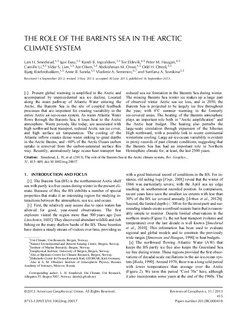| dc.identifier.citation | Smedsrud, L. H., et al. (2013), The role of the Barents Sea in the Arctic climate system, Rev. Geophys., 51, 415–449, doi:10.1002/rog.20017. | no_NO |
| dc.description.abstract | Present global warming is amplified in the Arctic and accompanied by unprecedented sea ice decline. Located along the main pathway of Atlantic Water entering the Arctic, the Barents Sea is the site of coupled feedback processes that are important for creating variability in the entire Arctic air-ice-ocean system. As warm Atlantic Water flows through the Barents Sea, it loses heat to the Arctic atmosphere. Warm periods, like today, are associated with high northward heat transport, reduced Arctic sea ice cover, and high surface air temperatures. The cooling of the Atlantic inflow creates dense water sinking to great depths in the Arctic Basins, and similar to 60% of the Arctic Ocean carbon uptake is removed from the carbon-saturated surface this way. Recently, anomalously large ocean heat transport has reduced sea ice formation in the Barents Sea during winter. The missing Barents Sea winter ice makes up a large part of observed winter Arctic sea ice loss, and in 2050, the Barents Sea is projected to be largely ice free throughout the year, with 4 degrees C summer warming in the formerly ice-covered areas. The heating of the Barents atmosphere plays an important role both in Arctic amplification and the Arctic heat budget. The heating also perturbs the large-scale circulation through expansion of the Siberian High northward, with a possible link to recent continental wintertime cooling. Large air-ice-ocean variability is evident in proxy records of past climate conditions, suggesting that the Barents Sea has had an important role in Northern Hemisphere climate for, at least, the last 2500 years. | no_NO |
